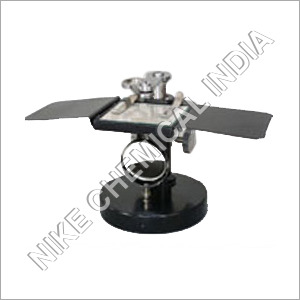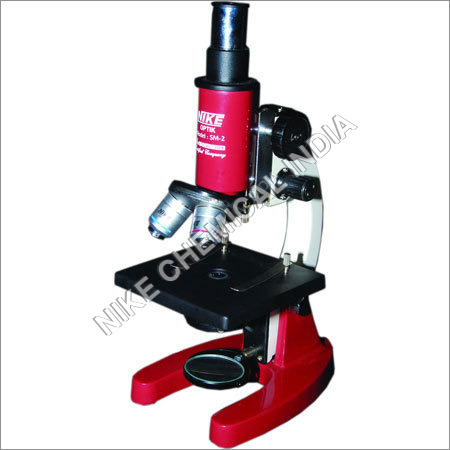- Home Page
- Company Profile
-
Our Products
- Laboratory Chemical
- Ammonium Compounds
- Aluminium Compounds
- Barium Compounds
- Copper Compounds
- Lead compounds
- Magnesium Compounds
- Potassium Compounds
- Sodium Compounds
- Zinc Compounds
- Chemical Packaging
- General Chemical
- Laboratory Solvents
- Laboratory Stains & Indicators
- Water treatment Chemical
- Laboratory Centrifuge
- Laboratory Glasswares
- Laboratory Plasticwares
- Microscope
- Biology
- Chemistry Lab Equipments
- Physics Lab Instruments
- NEWTONS COLOR DISC
- Wire Wound Rheostats
- Slotted Weight
- PLUG TYPE RESISTANCE BOX
- Lab Post Office Box
- Micrometer Screw Gauge
- Vernier Caliper
- COMPOUND PENDULUM
- KATERS REVERSIBLE PENDULUM
- MAXWELL NEEDLE
- Conductivity Apparatus Lees and Charltons
- Laboratory Flywheel
- TORSION PENDULUM
- Poiseuilles Viscosity Apparatus
- Viscosity Apparatus Stokes Method
- U-Tube Manometer
- Stefans Radiation Constant Apparatus
- Resistance Box
- Continuous Flow Calorimeter
- Copper Constantan Thermocouple
- Jaggers Surface Tension Apparatus
- WAVE MOTION APPARATUS
- LINEAR EXPANSION APPARATUS
- Laboratory Inclined Plane
- Laboratory Sonometer
- Laboratory Meter Bridge
- Linear Potentiometer
- Clement and Desormes Apparatus
- Physics Lab Electric Bell
- Reversing Key
- Morse Key
- Function Generator
- Wheel and Axle
- P N JUNCTION DIODE
- Steam Generator
- Joules Calorimeter
- COPPER WATER BATH
- Drawing Board
- Oven & Incubator
- Water Bath
- Laboratory Testing Instruments
- Contact Us
Dissecting Microscope
MOQ : 1000 Pieces
Dissecting Microscope Specification
- Focus System
- Coarse and fine adjustment knobs
- Features
- Sturdy metal construction, easy specimen handling, suitable for educational and laboratory use
- Spare Parts
- Extra eyepiece, stage clips, mirror
- Application
- Laboratory
- View Head
- Monocular
- Theory
- Used for observation and dissection of small specimens in laboratory settings.
- Drawtube
- Straight
- Resolution
- Optical; depends on magnification and eyepiece quality
- Interface
- Mechanical stage controls
- Focal Distance
- Working distance optimized for specimen viewing
- Magnification
- 10x and 20x
- Dimensions
- Compact desktop size
- Focus Range
- Adjustable coarse and fine focus ranges
- Eyepieces
- 10X
- Eyepiece Tube
- Single; straight tube
- Illumination
- Substage plano-concave mirror for reflected and transmitted light
- Coarse Adjustment Range
- Provided via rack and pinion system
- Fine Adjustment Range
- Helical gear type mechanism
- Working Stage
- Circular glass stage with two stage clips
- Image Format
- Real-time observation
- Interpupillary Distance
- Fixed
- Objective Achromatic
- 4X
- Condenser
- Not present; illumination provided by mirror
- Light Source
- Natural reflected or transmitted light via mirror
Dissecting Microscope Trade Information
- Minimum Order Quantity
- 1000 Pieces
- Payment Terms
- Letter of Credit (L/C), Letter of Credit at Sight (Sight L/C), Telegraphic Transfer (T/T)
- Supply Ability
- 1000 Pieces Per Month
- Delivery Time
- 7 Days
- Sample Available
- Yes
- Sample Policy
- Sample costs shipping and taxes has to be paid by the buyer
- Main Domestic Market
- All India
About Dissecting Microscope
Dissecting Microscope
With the help of our state-of-the-art infrastructure facility, we are engaged in manufacturing, supplying and exporting robustly-built Dissecting Microscope. This microscope is designed using cutting-edge technology so that the final output meets with the international quality standards. High grade raw materials that are procured from authentic vendors of the market are used in the manufacturing process of this microscope. To attain maximum customer satisfaction, this microscope is stringently tested on various parameters to ensure its high performance. Dissecting Microscope is used to examine the structure of dead animals or plants in various laboratories and research centers.
Other information:
Dissecting MicroscopeHeavy round base with nicely designed body, sensitive focusing is done by rack and pinion. A joint revolving arm is provided for moving magnifying lens over full area of stage. It is Easily replaceable by a special Bull Eye lens 80mm dia to increase the field of version. A Plano concave mirror is fork for light reflection.
Exceptional Construction for Reliable Usage
Constructed from premium die-cast metal with a heavy cast iron base, this dissecting microscope boasts exceptional durability and stability, minimizing unwanted movement during precise laboratory work. Corrosion-resistant enamel paint preserves the instruments appearance and longevity, even after extended use in demanding environments.
Enhanced Viewing Capabilities
The microscope offers clear, real-time observation of specimens through 10x and 20x magnification settings. Its optical resolution depends on quality lenses and eyepieces, ensuring crisp imaging for educational and laboratory applications. The straight monocular eyepiece tube and fixed interpupillary distance offer user-friendly operation for students and professionals alike.
Optimized for Efficient Laboratory Processes
This microscope features a circular glass stage with stage clips, allowing secure placement of slides and specimens. Focus adjustments are achieved through coarse rack and pinion and fine helical settings, while a plano-concave mirror provides both reflected and transmitted natural light. Its compact, desktop-friendly size makes it suitable for a range of laboratory setups.
FAQs of Dissecting Microscope:
Q: How do you use the Dissecting Microscope for specimen observation?
A: To use the microscope, place your prepared slide or specimen on the circular glass stage, secure it with the stage clips, then adjust the coarse and fine focus knobs to bring the image into sharp view. The substage plano-concave mirror should be aligned to direct natural light onto the specimen for optimal visibility.Q: What are the main benefits of this microscope for educational and laboratory use?
A: The microscope offers sturdy construction, corrosion-resistant coatings, and precise focusing, making it ideal for repeated classroom and laboratory use. Its real-time observation and easy handling support detailed dissection and analysis, providing clear magnification and stability during operation.Q: When is it preferable to use a dissecting microscope compared to a compound microscope?
A: Dissecting microscopes are best for observing and dissecting larger, three-dimensional specimens that do not require very high magnification. Use it in scenarios where surface details and manipulation of specimens are required, such as studying plant parts, insects, or small organisms in laboratory or educational settings.Q: Where should the microscope be placed for optimal performance?
A: Position the microscope on a stable, flat surface near a natural light source. Ensure there is enough space around the unit for comfortable handling of slides and materials. The heavy cast iron base and compact size help maintain stability during use.Q: What accessories are compatible with this dissecting microscope?
A: This microscope is compatible with prepared slides and dissecting needles. Common spare parts include extra eyepieces, stage clips, and mirrors, which ensure continued functionality and convenience during extended laboratory sessions.Q: How is light provided and controlled for specimen viewing?
A: Natural light is directed onto specimens using a substage plano-concave mirror. The mirror can be adjusted to provide either transmitted or reflected light, enhancing visibility depending on the opacity and nature of the specimen being observed.Q: What is the process for adjusting the focus accurately?
A: Begin by using the coarse adjustment knob to get a general focus on the specimen, then switch to the fine adjustment (helical gear mechanism) to bring finer details into sharp relief. The microscopes adjustment system allows for both broad and precise focusing to suit various specimen sizes and observation needs.
Tell us about your requirement

Price:
Quantity
Select Unit
- 50
- 100
- 200
- 250
- 500
- 1000+
Additional detail
Mobile number
Email
More Products in Microscope Category
Newtons Ring Microscope
Minimum Order Quantity : 1000 Pieces
Eyepieces : Huygenian or Ramsden type, single monocular viewing.
Application : Laboratory Use
Drawtube : Other, Smooth sliding drawtube for fine focusing and adjustment.
Illumination : Compact substage planoconcave mirror with adjustable focusing mechanism.
Magnification : 30x
Travelling Microscope
Minimum Order Quantity : 1000 Pieces
Eyepieces : Provided, standard wide field (WF 10x).
Application : Laboratory
Drawtube : Other, Fixed drawtube for stable observations.
Illumination : Mirror attachment for ambient/artificial light focusing.
Magnification : 10x
STUDENT MICROSCOPE
Minimum Order Quantity : 1000 Pieces
Eyepieces : 10x 16x
Application : Laboratory Use
Drawtube : Other, Straight monocular drawtube.
Illumination : Mirror illumination for natural or artificial light source.
Magnification : Up to 675x depending on eyepiece and objective used.
Binocular Microscope
Minimum Order Quantity : 1000 Pieces
Eyepieces : Wide field Eyepiece WF 10x/18 mm
Application : Laboratory
Drawtube : Binocular
Illumination : 6V 20W Halogen Lamp

 Send Inquiry
Send Inquiry





